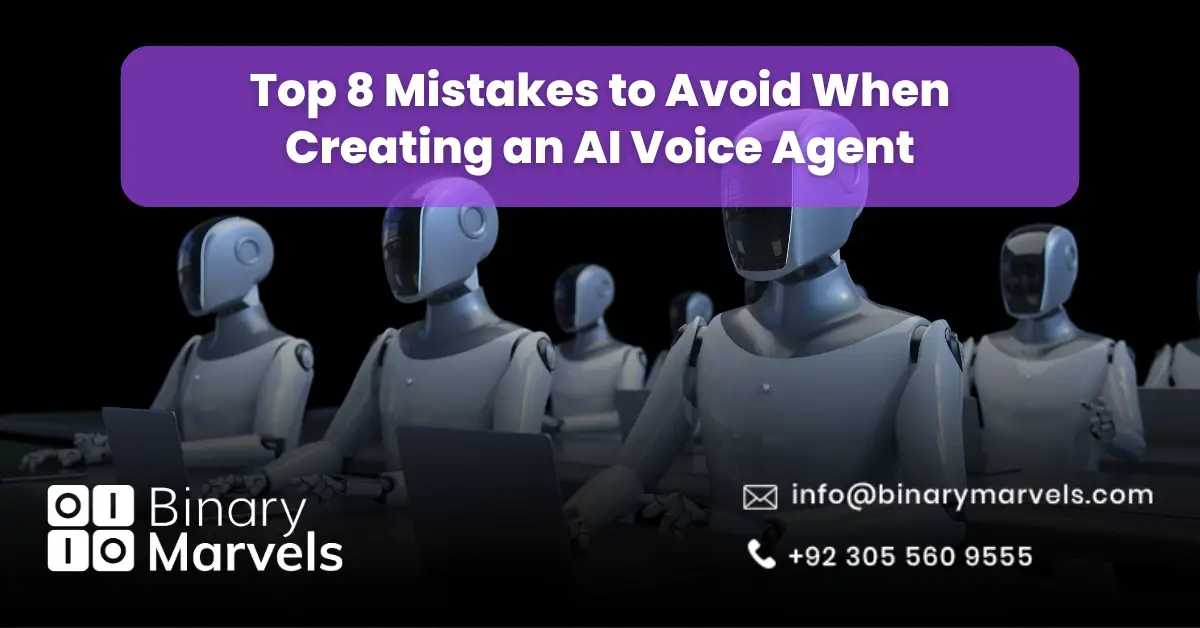
AI voice agents are transforming how businesses handle calls, automate support, and scale customer service. From streamlining outbound campaigns to handling thousands of inbound queries, these intelligent systems offer speed, consistency, and 24/7 availability. But here’s the catch: building an effective AI voice agent isn’t just about plugging in the latest tools — it’s about crafting a smart, reliable experience that actually works in the real world.
Unfortunately, many teams rush into AI voice agent development and hit roadblocks — poor conversation design, messy data flow, or a lack of testing that leads to awkward user experiences. These mistakes can cost businesses both money and trust. In this guide, we’ll uncover the top 8 mistakes to avoid when building your AI voice agent — and more importantly, we’ll show you how to fix them using real-world strategies and proven best practices.
Also Read: Top 10 AI Companies in Pakistan
Top 8 Mistakes to Avoid When Creating an AI Voice Agent
❌ 1. Skipping Real-World Testing Scenarios
Testing your AI voice agent in a controlled environment is a good start, but it’s not enough. One of the biggest mistakes developers make is failing to test the agent in real-world conditions that customers actually experience. Things like background noise, strong accents, fast speech, and unexpected responses can all throw off a poorly tested voice agent.
When your AI only performs well in ideal situations, you risk launching a system that fumbles basic queries, frustrates users, and damages your brand reputation. Voice agents need to be stress-tested like human agents, with edge cases, interruptions, and varying call flows.
✅ How to Fix It:
- Test in environments with ambient noise and multiple accents.
- Simulate dropped calls, repeated questions, and misheard input.
- Use voice AI testing tools like Twilio Autopilot’s simulator or Google Dialogflow’s built-in debugger.
- Regularly review call logs and transcripts to spot patterns in misunderstandings.
Also Read: A Guide to AI Voice Agent Development
❌ 2. Ignoring Default Settings and Language Models
Many teams overlook one critical step when setting up their AI voice agent: properly configuring the default settings and choosing the right language model. Out-of-the-box configurations often aren’t optimized for your specific use case, leading to frustrating experiences like generic responses, incorrect intent detection, or delayed replies.
Common missteps include setting the confidence threshold too low (causing false positives), failing to configure fallback intents, or choosing a text-to-speech (TTS) voice that doesn’t match your brand’s tone. These small details can make your AI sound robotic, irrelevant, or even rude — and users will notice.
✅ How to Fix It:
- Adjust the confidence score threshold for intent matching — a typical sweet spot is between 0.6 and 0.8, depending on the model.
- Set up clear fallback intents and no-input handlers to gracefully handle uncertainty.
- Select a natural-sounding TTS voice that fits your audience and language preference.
- If your platform supports it, choose domain-specific or custom-trained language models to better understand industry jargon.
❌ 3. Writing Prompts Like a Script, Not a Conversation
A common mistake in AI voice agent development is designing conversations like a rigid call script rather than a dynamic, natural interaction. Unlike IVR systems or traditional chatbots, modern AI voice agents are expected to engage like humans — but that won’t happen if your prompts are robotic, overly formal, or too long.
If your agent sounds like it’s reading from a script, users are more likely to interrupt, get confused, or hang up. Even worse, scripted prompts limit the agent’s ability to adapt to real user behavior, causing conversation breakdowns and high abandonment rates.
✅ How to Fix It:
- Use short, conversational prompts that match how people speak.
- Design for multiple paths by anticipating variations in user responses.
- Use contextual continuity — refer back to what users previously said to keep the flow natural.
- Test prompt tone and timing to avoid overlaps or awkward silences.
Also Read: Revamp Your Call Center with VICIDial Development Services
❌ 4. Overloading a Single Bot with Too Many Integrations
Trying to make one AI voice agent do everything — from booking appointments to managing payments to troubleshooting — is a recipe for chaos. Overloading your agent with too many tools or functions often leads to confused task flows, slower response times, and a frustrating user experience.
Each integration (CRM, calendar, payment gateway, ticketing system, etc.) adds complexity. If not handled carefully, the agent may struggle to juggle them all, causing errors, timeouts, or mismatched intents. Plus, it makes future updates harder and increases the chance of system crashes or data leaks.
✅ How to Fix It:
- Break complex workflows into modular tasks or use microservices that interact with the core agent.
- Assign different bots or submodules for specific purposes (e.g., billing assistant, appointment bot).
- Use API call chaining wisely — limit the number of simultaneous requests during a single conversation.
- Monitor logs for performance drops during integration-heavy interactions.
❌ 5. Lacking Error Recovery and Clarification Mechanisms
Even the smartest AI voice agents will misunderstand users at some point — it’s inevitable. But what separates a good system from a bad one is how well it recovers. A major mistake in voice agent development is failing to implement proper fallback strategies, clarification prompts, and error-handling flows.
If your AI responds with “Sorry, I didn’t get that” — and then just repeats the same question — you’ve lost the user. Without graceful recovery, the conversation can spiral into confusion, silence, or worse, a hang-up.
✅ How to Fix It:
- Design multi-level fallback intents — don’t just repeat, rephrase with more context.
- Add clarification prompts: “Did you mean billing or technical support?”
- Use timeout handlers to catch silence and offer next steps.
- Include human escalation options when confidence drops below a threshold or after repeated failures.
❌ 6. Hard-Coding Variables Without Proper Logic
Voice agents often need to capture and use data — like names, phone numbers, dates, or account numbers — to personalize conversations or complete tasks. But many developers make the mistake of hard-coding variables or failing to manage them dynamically. This results in data mismatches, broken flows, and poor user experiences.
When variables aren’t properly validated, stored, or passed between steps, the agent might forget critical info, confuse user inputs, or respond with irrelevant data. It’s like a call center rep forgetting your name halfway through the call — not a good look.
✅ How to Fix It:
- Use slot filling or entity extraction to capture user input in real-time.
- Validate variables (e.g., phone number formats, date ranges) using input validators or regex patterns.
- Store and reuse variables using session context or global parameters.
- Avoid hard-coding values — use dynamic data binding and test edge cases where inputs may be missing or unclear.
Also Read: Why Your Business Needs an AI Agent for Outbound Calls?
❌ 7. Disorganized Call Flow with No Intent Linking
A well-structured conversation should feel natural, seamless, and purposeful. But when your AI voice agent lacks a clear call flow or has poorly linked intents, it ends up sounding disjointed — jumping between topics, repeating questions, or getting stuck in loops.
This often happens when developers treat intents as isolated blocks rather than a connected journey. Without logical transitions and flow control, your voice agent won’t understand user context or guide them efficiently toward a goal.
✅ How to Fix It:
- Map out the entire call journey before building intents — use visual flowcharts or conversation trees.
- Use intent linking or follow-up intents to maintain continuity between steps.
- Leverage context variables to track the user’s stage in the flow.
- Add exit and escalation conditions to prevent dead ends.
❌ 8. Incorrectly Formatting the CSV File for Call Campaigns
When launching outbound call campaigns with your AI voice agent, the CSV file used to feed contact data is the backbone of the operation. One wrong column, missing value, or inconsistent format can cause your campaign to crash or misdial. Sadly, this is one of the most overlooked but costly mistakes — especially when scaling to thousands of contacts.
Without proper formatting, your voice agent might call the wrong person, skip leads entirely, or insert broken variables into the conversation (e.g., “Hello [blank], your account balance is [error]”).
✅ How to Fix It:
- Use consistent column headers that exactly match your system’s data mapping requirements.
- Clean your data — remove duplicates, empty cells, and invalid entries.
- Ensure fields like phone numbers follow a uniform format (e.g., +1XXXXXXXXXX for North America).
- Validate the CSV file with a pre-upload checker or sandbox test before launching a full campaign.
Also Read: The Benefits of Voice AI Agents for Call Centers
Conclusion
Creating a high-performing AI voice agent goes far beyond writing a few prompts or connecting APIs. It requires thoughtful planning, real-world testing, and an understanding of how users actually interact with automation. By avoiding the common pitfalls covered in this guide — from misconfigured settings to chaotic call flows — you can ensure your AI voice agent delivers a smooth, professional, and reliable experience.
Remember, your voice agent often is your brand’s first impression. Don’t let basic mistakes ruin a powerful opportunity to automate, scale, and serve better. Build smart, test smarter — and always keep the human on the other end in mind.
Supercharge Your Business with AI Agents Today!
As a trusted AI Development Company in Pakistan, Binary Marvels delivers smart, scalable AI solutions that enhance outbound performance, streamline operations, and drive measurable results. From call centers to fast-growing startups, our AI voice agents are built to convert.
Don’t wait—connect with us today and discover how Voice AI can take your business to the next level.
FAQs
What is an AI voice agent and how does it work?
An AI voice agent is a software-powered system that uses speech recognition, natural language processing (NLP), and text-to-speech (TTS) to simulate human-like conversations over phone calls. It understands user input, performs tasks, and replies using pre-trained models and real-time logic.
Why is testing AI voice agents in real-world scenarios important?
Real-world testing ensures the voice agent performs well under practical conditions — including background noise, diverse accents, and natural interruptions — which helps reduce misunderstandings and improve speech accuracy and intent recognition.
How do I fix CSV formatting issues in outbound voice AI campaigns?
Use a clean, validated CSV with consistent headers, proper phone number formatting, and no missing values. Platforms like VICIDial or Twilio often provide CSV templates to follow for predictive dialing and automated campaign setup.
What platforms are best for building AI voice agents?
Popular platforms include Google Dialogflow, Amazon Lex, Twilio Autopilot, Rasa, and Microsoft Azure Bot Framework. These offer built-in NLU, TTS, integrations, and flow design tools tailored for voice-based interaction.
How can I improve error handling in my AI voice agent?
Implement fallback prompts, clarification questions, intent re-tries, and human handoff protocols. Use confidence thresholds and session variables to track user interactions and adapt responses intelligently.









